INSTITUT SUPERIEUR D'ANTHROPOLOGIE
INSTITUTE OF ANTHROPOLOGY
ONLINE COURSES / COURS A DISTANCE
OPEN COURSE : FEBRUARY 2013
HRM 104 : INTRODUCTION TO INTANGIBLE CULTURAL HERITAGE
REGISTER NOW
MEXIQUE – 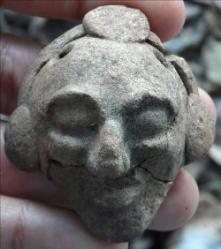 Xtojil - Archaeologists have found a dozen Mayan burial sites dating back more than 1,200 years at the Xtojil site, located some 20 kilometers (12 miles) from Chichen Itza in the Yucatan Peninsula, the National Anthropology and History Institute (INAH) said. Most of the skeletal remains were discovered in lithic tombs known as “cistas” (rectangular caskets protected and covered by stone slabs) that also contained some 30 ceramic pieces, two of which have hieroglyphs, the INAH said in a statement. The find was made during excavation work to expand a highway in that region, the INAH said. The tombs were placed between 600-800 A.D., prior to Chichen Itza’s emergence as a great ceremonial and political hub in the northern part of the peninsula.
Xtojil - Archaeologists have found a dozen Mayan burial sites dating back more than 1,200 years at the Xtojil site, located some 20 kilometers (12 miles) from Chichen Itza in the Yucatan Peninsula, the National Anthropology and History Institute (INAH) said. Most of the skeletal remains were discovered in lithic tombs known as “cistas” (rectangular caskets protected and covered by stone slabs) that also contained some 30 ceramic pieces, two of which have hieroglyphs, the INAH said in a statement. The find was made during excavation work to expand a highway in that region, the INAH said. The tombs were placed between 600-800 A.D., prior to Chichen Itza’s emergence as a great ceremonial and political hub in the northern part of the peninsula.
http://www.laht.com/article.asp?ArticleId=662627&CategoryId=13936
ROYAUME UNI – 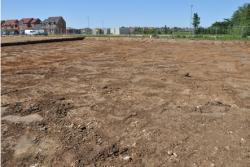 Navenby - A dig for Roman remains in Navenby hopes to reveal details of daily life in 1st century Britain. The village of Navenby lies on Ermine Street, one of Britain's most important Roman roads where previous HLF-funded surveys and field-walking finds close to Ermine Street in Navenby have indicated Roman settlements. Preparations and scheduling for the new project are now underway and it is hoped on-site work will begin in the Spring. The dig in 2009 revealed remains of buildings, believed to be shop-fronts with workshops and dwellings behind them. Further surveys and a test excavation suggest that similar remains could be found at the proposed site, again off Ermine Street. The site is unusual because it has never been cultivated and so archaeologists are expecting the finds to be near the surface and well preserved. Finds will reveal more about how the Romans lived, for instance how patterns of scattered pot could indicate dwellings or industrial areas. Evidence of habitation likely to be found on the site includes pottery, tessara from floors, coins, glass, perhaps pieces of flint, and oyster shells, which were a common source of cheap food rather than the high status food they are nowadays.
Navenby - A dig for Roman remains in Navenby hopes to reveal details of daily life in 1st century Britain. The village of Navenby lies on Ermine Street, one of Britain's most important Roman roads where previous HLF-funded surveys and field-walking finds close to Ermine Street in Navenby have indicated Roman settlements. Preparations and scheduling for the new project are now underway and it is hoped on-site work will begin in the Spring. The dig in 2009 revealed remains of buildings, believed to be shop-fronts with workshops and dwellings behind them. Further surveys and a test excavation suggest that similar remains could be found at the proposed site, again off Ermine Street. The site is unusual because it has never been cultivated and so archaeologists are expecting the finds to be near the surface and well preserved. Finds will reveal more about how the Romans lived, for instance how patterns of scattered pot could indicate dwellings or industrial areas. Evidence of habitation likely to be found on the site includes pottery, tessara from floors, coins, glass, perhaps pieces of flint, and oyster shells, which were a common source of cheap food rather than the high status food they are nowadays.
http://www.thisislincolnshire.co.uk/Dig-Navenby-hopes-uncover-history-Britain-s/story-17870341-detail/story.html
ISRAËL – 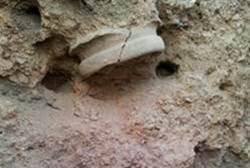 Shilo - An ancient vase that provided evidence that Shilo was sacked by Philistines has been stolen from the Shilo site. Avital Sela, who manages the site, told Arutz Sheva that once the vase was discovered to have been stolen, a complaint was filed with police. Sela explained that the vase, which was dated precisely to the year in which the destruction of Shilo was assumed to have taken place, "connected all of the Biblical pieces into one puzzle." The First Book of Samuel does not say when and how Shilo, which served as the Israelite capital for 369 years, was destroyed. The vase, along with remains of ashes from a fire, indicate large scale destruction at the same period in which the War of Even Ha'ezer (Ebenezer) against the Philistines was waged. Israel suffered a crushing defeat in that war, which is believed to have been waged near present-day Afek. The two sons of Eli the High Priest were killed, and Eli himself died upon hearing the news. Worst of all, the Holy Ark, which the Israelites had brought to the battleground, was taken by the Philistines. With the vase, archeologists and scholars now had more evidence to back the assumption that after defeating the Israelites at Even Ha'ezer, the Philistines advanced upon Shilo and sacked it.
Shilo - An ancient vase that provided evidence that Shilo was sacked by Philistines has been stolen from the Shilo site. Avital Sela, who manages the site, told Arutz Sheva that once the vase was discovered to have been stolen, a complaint was filed with police. Sela explained that the vase, which was dated precisely to the year in which the destruction of Shilo was assumed to have taken place, "connected all of the Biblical pieces into one puzzle." The First Book of Samuel does not say when and how Shilo, which served as the Israelite capital for 369 years, was destroyed. The vase, along with remains of ashes from a fire, indicate large scale destruction at the same period in which the War of Even Ha'ezer (Ebenezer) against the Philistines was waged. Israel suffered a crushing defeat in that war, which is believed to have been waged near present-day Afek. The two sons of Eli the High Priest were killed, and Eli himself died upon hearing the news. Worst of all, the Holy Ark, which the Israelites had brought to the battleground, was taken by the Philistines. With the vase, archeologists and scholars now had more evidence to back the assumption that after defeating the Israelites at Even Ha'ezer, the Philistines advanced upon Shilo and sacked it.
http://www.israelnationalnews.com/News/News.aspx/164217#.UPgsJyfX62Y
TURQUIE –  Stratonikeia - The world’s largest marble city, the ancient city of Stratonikeia in the Aegean province of Muğla’s Yatağan district, is expected to be included on the temporary list of UNESCO world heritage sites. The head of excavations at the ancient city and Pamukkale University Professor Bilal Söğüt said Stratonikeia, one of the most important cities in the Caria region, was a settlement of Carians and Lelegs, both local Anatolian populations, and also survived as a settlement during the Hellenistic, Byzantine, Ottoman and Republican period. Söğüt said that the latest excavations had begun in Stratonikeia in June 2012 with the participation of 50 academics and students from eight universities as well as 40 workers. He said that each academic carried out work in his own area of expertise, mainly in the ancient theater, gymnasium, basilica, graves and city walls. “Structures from different periods in the ancient city were restored for visits. Greek, Latin and Ottoman scriptures can be seen on the same structure together. The city is culturally rich in this sense,” he added. Söğüt said that 725 artifacts had been found during 2012 excavations and all of them had been conserved and restored. “225 of these pieces can directly go on view. All discussions regarding restoration work have been completed and the artifacts were delivered to the Muğla Museum. The strong columns that were found in the western street were revived. Looking at this 10-meter wide street is enough to understand the magnificence of Stratonikeia.” Söğüt said the theater in the city had been built with a temple. “Stratonikeia is one of the places where the theater and temple relation can be seen the best. The theater, which has a capacity of 15,000 people, has been excavated and conservations work has been finished. The most perfect sewage system of the ancient era has been found in the theater. We are very pleased because it is in good enough condition to be used even today.”
Stratonikeia - The world’s largest marble city, the ancient city of Stratonikeia in the Aegean province of Muğla’s Yatağan district, is expected to be included on the temporary list of UNESCO world heritage sites. The head of excavations at the ancient city and Pamukkale University Professor Bilal Söğüt said Stratonikeia, one of the most important cities in the Caria region, was a settlement of Carians and Lelegs, both local Anatolian populations, and also survived as a settlement during the Hellenistic, Byzantine, Ottoman and Republican period. Söğüt said that the latest excavations had begun in Stratonikeia in June 2012 with the participation of 50 academics and students from eight universities as well as 40 workers. He said that each academic carried out work in his own area of expertise, mainly in the ancient theater, gymnasium, basilica, graves and city walls. “Structures from different periods in the ancient city were restored for visits. Greek, Latin and Ottoman scriptures can be seen on the same structure together. The city is culturally rich in this sense,” he added. Söğüt said that 725 artifacts had been found during 2012 excavations and all of them had been conserved and restored. “225 of these pieces can directly go on view. All discussions regarding restoration work have been completed and the artifacts were delivered to the Muğla Museum. The strong columns that were found in the western street were revived. Looking at this 10-meter wide street is enough to understand the magnificence of Stratonikeia.” Söğüt said the theater in the city had been built with a temple. “Stratonikeia is one of the places where the theater and temple relation can be seen the best. The theater, which has a capacity of 15,000 people, has been excavated and conservations work has been finished. The most perfect sewage system of the ancient era has been found in the theater. We are very pleased because it is in good enough condition to be used even today.”
http://www.hurriyetdailynews.com/stratonikeia-eyes-unesco-list.aspx?pageID=238&nID=39212&NewsCatID=375
GRECE – 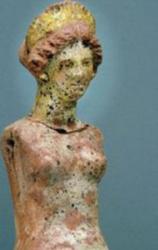 Pella - A clay doll with tall legs, a slim figure and a thorough hairstyle had probably been the favorite toy of a girl back in ancient Macedonia dating to the 4th-Century B.C. This distant ancestor of Barbie, along with other ancient games, are in the collection of the new Archaeological Museum of Pella, among other treasures. However, these games are not part of a rare archaeological find. It is possible for many great museums to have such objects in their disposal, but the Museum of Pella is presenting them on its shelves giving kindergarten students the chance experience the ancient games, play with and even paint them. This activities will take place at the museum Jan. 24-25 within the framework of Painting on Ancient Games of Pella’s Museum. An archaeologist of the XXI Prehistoric and Classical Antiquities Anastasia Georgiadou said that, “We have selected some toys from the museum’s collection to show them to the children. We decided to present these objects next to modern toys, the doll next to a Barbie, playing pawns next to chess, the cicada next to a rattle used nowadays, so that children can better understand these kind of objects.”
Pella - A clay doll with tall legs, a slim figure and a thorough hairstyle had probably been the favorite toy of a girl back in ancient Macedonia dating to the 4th-Century B.C. This distant ancestor of Barbie, along with other ancient games, are in the collection of the new Archaeological Museum of Pella, among other treasures. However, these games are not part of a rare archaeological find. It is possible for many great museums to have such objects in their disposal, but the Museum of Pella is presenting them on its shelves giving kindergarten students the chance experience the ancient games, play with and even paint them. This activities will take place at the museum Jan. 24-25 within the framework of Painting on Ancient Games of Pella’s Museum. An archaeologist of the XXI Prehistoric and Classical Antiquities Anastasia Georgiadou said that, “We have selected some toys from the museum’s collection to show them to the children. We decided to present these objects next to modern toys, the doll next to a Barbie, playing pawns next to chess, the cicada next to a rattle used nowadays, so that children can better understand these kind of objects.”
http://greece.greekreporter.com/2013/01/15/dolls-and-ancient-games-at-pella-museum/
ROYAUME UNI – 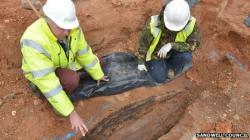 West Bromwich - Archaeologists have found evidence of grave robbing while digging at a 19th Century burial ground in West Bromwich. A team working at the former Providence Baptist Chapel site found a mortsafe - a metal cage fixed around a coffin to stop people stealing the body. Empty coffins and one filled with scrap metal were also discovered which archaeologists said was evidence of attempts to deter body snatchers. Sandwell Council's Museums Manager, Frank Caldwell said: "The body protected by the mortsafe belonged to a young woman who we found suffered from a disfiguring skin and bone disease. "It meant that her remains would have fetched a premium for the body snatchers and that would be why her body was protected by the mortsafe - her family were concerned that it would be stolen." Mr Caudwell said West Bromwich would have been a prime target for the grave robbers supplying the anatomy and medical schools that were being set up in Birmingham in the late 1700s. "The simplest method of protecting the graves was to employ a guard," he said. "However it appears from records in other towns that the money paid for a fresh body, which could be over £25, that these guards were often bribed to turn a blind eye. " Archaeologists also found a brick coffin where the body at the top was hiding a false bottom with another person buried beneath. Following the excavation, the remains from the 148 graves were removed and given a Baptist burial in Heath Lane cemetery. "We were not able to put names to any of the skeletons as the name plates from all the coffins would have been made out of cheap thin tinplate and had all corroded to dust," said Mr Caudwell. "One intriguing find was a musket ball in one of the coffins - we presume it contributed to that person's death but research has not helped us identify any shootings in West Bromwich at this period. Some secrets are literally taken to the grave."
West Bromwich - Archaeologists have found evidence of grave robbing while digging at a 19th Century burial ground in West Bromwich. A team working at the former Providence Baptist Chapel site found a mortsafe - a metal cage fixed around a coffin to stop people stealing the body. Empty coffins and one filled with scrap metal were also discovered which archaeologists said was evidence of attempts to deter body snatchers. Sandwell Council's Museums Manager, Frank Caldwell said: "The body protected by the mortsafe belonged to a young woman who we found suffered from a disfiguring skin and bone disease. "It meant that her remains would have fetched a premium for the body snatchers and that would be why her body was protected by the mortsafe - her family were concerned that it would be stolen." Mr Caudwell said West Bromwich would have been a prime target for the grave robbers supplying the anatomy and medical schools that were being set up in Birmingham in the late 1700s. "The simplest method of protecting the graves was to employ a guard," he said. "However it appears from records in other towns that the money paid for a fresh body, which could be over £25, that these guards were often bribed to turn a blind eye. " Archaeologists also found a brick coffin where the body at the top was hiding a false bottom with another person buried beneath. Following the excavation, the remains from the 148 graves were removed and given a Baptist burial in Heath Lane cemetery. "We were not able to put names to any of the skeletons as the name plates from all the coffins would have been made out of cheap thin tinplate and had all corroded to dust," said Mr Caudwell. "One intriguing find was a musket ball in one of the coffins - we presume it contributed to that person's death but research has not helped us identify any shootings in West Bromwich at this period. Some secrets are literally taken to the grave."
http://www.bbc.co.uk/news/uk-england-birmingham-21044770